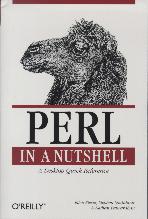
This book was hard to review, because it is a reference guide. One thing is clear: the authors have made it a good reference guide.

Authors: Ellen Siever, Stephen Spainhour and Nathan Patwardhan
Publisher: O'Reilly & Associates
E-mail: info@ora.com
URL: http://www.ora.com/
Price: $24.95
ISBN: 1565922867
Reviewer: Jan Rooijackers
A quick stroll through the book gave me the impression that much time was spent putting it together. The book is divided into eight parts, each containing one or more chapters.
Chapter 1 is a small but very useful chapter. It explains how Perl can be used and which platforms support it. The most important paragraph in this chapter is “Perl Resources”. All well-known resources are mentioned here: newsgroups, FAQs (frequently asked questions), web pages and other books from the publisher.
Now that you know how to get Perl, it is time you got it installed. Specific installation topics like installing modules and documentation are explained in Chapter 2.
In Chapter 3, the Perl interpreter and its options are explained from command-line to environment variables. Chapter 4 explains the program structure. This chapter and the following one are good references for anyone already familiar with Perl or another programming language. If you are totally new to programming and you want to learn Perl, the book Learning Perl (Randal L. Swartz and Tom Christianson, also from O'Reilly) might be a better place to start.
Chapter 5 gives brief descriptions of the built-in functions. Each description covers the syntax of the function, with the types and order of its arguments. Since no one writes perfect code all the time, the debugger is explained with its various options. Packages, modules and objects are discussed in chapters 7 and 8. A short explanation and an example give you a good idea of how each standard module, delivered with Perl, is used.
CGI is covered in chapters 9 through 11. I feel this section will be used the most, because CGI together with the Internet is such a hot item. Many web pages make use of CGI scripts.
Chapter 11 discusses the useful things which can be done by mod_perl as it merges Perl into the Apache web server. This module will reduce the forking of extra processes each time a script is executed. Installing this module and making use of its capabilities can speed up execution on the server.
Chapter 12 explains the connection between databases and Perl. Databases are also a hot item on the Internet these days. DBM (database management) and DBI (database interface) are covered in this chapter.
Network topics such as sockets, e-mail, news, FTP and LWP (library for web access in Perl) are discussed in part six. Each chapter starts with a short description of the service, followed by the key words in alphabetical order along with their uses.
Perl/Tk is discussed in Chapter 18. I did some design work with Tcl/Tk in the past, and was amazed at how easy it was to get something done. With Perl and Tk, it is even simpler. Using the examples, you can quickly design some nice things.
The last chapter covers Win32 modules and extensions. With the information provided in this chapter, you could create some nice things in the Microsoft world.
The index may be the most important part of a book, in my opinion. A bad index will cost you time when searching for topics in a book. This index is so complete, you will easily find any desired information.
This book was hard to review, because it is a reference guide. One thing is clear: the authors have made it a good reference guide. This book is a must for people who already know Perl and want to learn more. The information you need is easy to find and understand due to clearly written text and good examples.